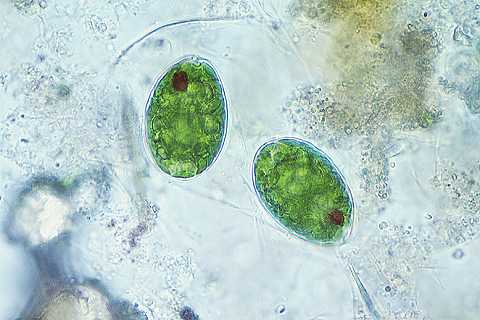
EUKARYOTA
Excavates
[Photo © www.micrographia.com]
Chapter Outline
- Description of Eukaryotes
- Classification of Eukaryotes
- Excavates
- Amoebozoa
- Rhizaria
- Alveolata
- Stramenopiles
- Algae
- Opisthokonta

Links to external sites will appear in pop-up windows.
TEXT
| PARABASALIA | |
"Flagellated protists with a parabasal apparatus of dictyosomes anchored to a striated root." The parabasalids are one of the groups of eukaryotes without mitochondria. They are usually symbionts in the intestines of wood-eating insects, though a few species are free living. [Patterson]
| Resources: |
| FORNICATA | |
This is another group of flagellates lacking mitochondria. All are free living or parasitic heterotrophs. Giardia is a well known genus in this group as it can cause sickness in hikers and other people who drink from streams without filtering or boiling the water.
Organisms:
Resources:
|
| OXYMONADIDA | |
"Amitochondriate protists with axostyle constituted of multiple sheets of microtubules." [Patterson]
Organisms:
| Resources: |
| JAKOBIDA | |
Free swimming or loricate mitochondriates with two basal bodies and two flagella located at the anterior end of a ventral feeding groove. [Patterson]
Organisms:
| Resources: |
| HETEROLOBOSEA (Amoeboflagellates) | |
"To be resolved but either discicristate protists forming eruptive pseudopodia or discicristate protists with parallel basal bodies inserting on an electron-dense pad, possibly with a substantial cross-striated root." [Patterson]
Organisms:
| Resources: |
| MALAWIMONADIDAE | |
"Malawimonas is a genus of small bacterivorous zooflagellates. The single species, M. jakobiformis, is known from a single locality on the western (Malawi) shore of Lake Nyasa, one of the great rift lakes in eastern Africa." [Protist Image Data]
Organisms:
| Resources: |
| EUGLENOZOA | |
"All euglenoids are essentially biflagellate and have two flagella that emerge from the anterior end of the cell. Many euglenoids, including most phototropic genera such as Euglena, have only a single emergent flagellum the length of one flagellum being highly reduced and giving the appearence that the cells are uniflagellate. In those species in which both flagella emerge the two flagella are often quite dissimilar both in terms of flagellar structure and function. Euglenoids can move in a number of ways including basic swimming motion, gliding along a substrate, or changing their body shape in a process known as euglenoid metaboly." The euglenoid cell surface, organized as a series of ridges and grooves, is unique among eukaryotes. [Euglenoid Project]
| Resources: |
| [ Previous Page ] | [ Next Page ] |